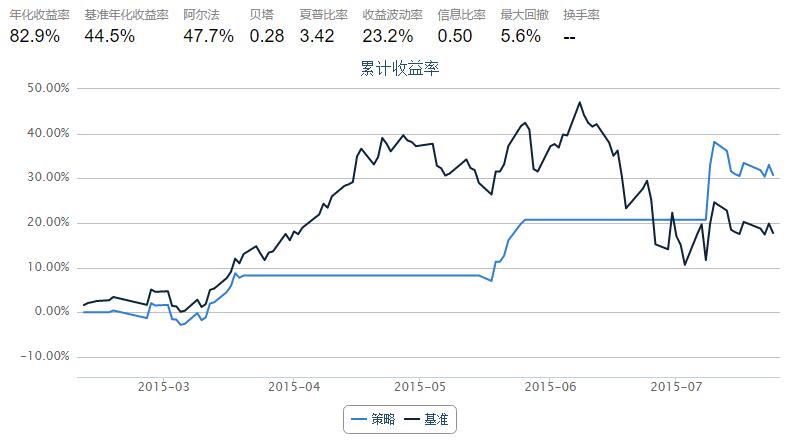基于 VIX 指数的择时策略
波动率VIX指数是跟踪市场波动性的指数,一般通过标的期权的隐含波动率计算得来,以芝加哥期权交易所的VIX指数为例,如标的期权的隐含波动率越高,则VIX指数相应越高,一般而言,该指数反映出投资者愿意付出多少成本去对冲投资风险。业内认为,当VIX越高时,表示市场参与者预期后市波动程度会更加激烈,同时也反映其不安的心理状态;相反,VIX越低时,则反映市场参与者预期后市波动程度会趋于缓和的心态。因此,VIX又被称为投资人恐慌指标(The Investor Fear Gauge)。
中国波指是由上证所发布,用于衡量上证50ETF未来30日的预期波动。该指数是根据方差互换的原理,结合50ETF期权的实际运作特点,并通过对上证所交易的50ETF期权价格的计算编制而得。网址为: http://www.sse.com.cn/assortment/derivatives/options/volatility/
本文中,基于优矿平台,自己尝试计算了日间的中国波指,并将其用在了华夏上证50的择时买卖上,以验证VIX指数对未来的预测性
由于上证所未发布其iVIX计算方法,所以此处的计算基于CBOE发布的方法,具体参见: http://www.cboe.com/micro/vix/part2.aspx
策略思路
- 当VIX指数快速上升时,表示市场恐慌情绪蔓延,产生卖出信号
- 当VIX指数快速下降时,恐慌情绪有所舒缓,产生买入信号
- 卖出买入信号均用来买卖华夏上证50ETF基金
注:国内唯一一只期权上证50ETF期权,跟踪标的为华夏上证50ETF(510050)基金
1. 计算历史VIX指数
from matplotlib import pylab
import numpy as np
import pandas as pd
import DataAPI
import seaborn as sns
sns.set_style('white')
from CAL.PyCAL import *
from pandas import Series, DataFrame, concat
import pandas as pd
import numpy as np
import seaborn as sns
sns.set_style('white')
from matplotlib import pylab
import time
import math
def getHistDayOptions(var, date):
# 使用DataAPI.OptGet,拿到已退市和上市的所有期权的基本信息;
# 同时使用DataAPI.MktOptdGet,拿到历史上某一天的期权成交信息;
# 返回历史上指定日期交易的所有期权信息,包括:
# optID varSecID contractType strikePrice expDate tradeDate closePrice
# 以optID为index。
vixDateStr = date.toISO().replace('-', '')
optionsMkt = DataAPI.MktOptdGet(tradeDate = vixDateStr, field = [u"optID", "tradeDate", "closePrice"], pandas = "1")
optionsMkt = optionsMkt.set_index(u"optID")
optionsMkt.closePrice.name = u"price"
optionsID = map(str, optionsMkt.index.values.tolist())
fieldNeeded = ["optID", u"varSecID", u'contractType', u'strikePrice', u'expDate']
optionsInfo = DataAPI.OptGet(optID=optionsID, contractStatus = [u"DE", u"L"], field=fieldNeeded, pandas="1")
optionsInfo = optionsInfo.set_index(u"optID")
options = concat([optionsInfo, optionsMkt], axis=1, join='inner').sort_index()
return options[options.varSecID==var]
def getNearNextOptExpDate(options, vixDate):
# 找到options中的当月和次月期权到期日;
# 用这两个期权隐含的未来波动率来插值计算未来30隐含波动率,是为市场恐慌指数VIX;
# 如果options中的最近到期期权离到期日仅剩1天以内,则抛弃这一期权,改
# 选择次月期权和次月期权之后第一个到期的期权来计算。
# 返回的near和next就是用来计算VIX的两个期权的到期日
optionsExpDate = Series(options.expDate.values.ravel()).unique().tolist()
near = min(optionsExpDate)
optionsExpDate.remove(near)
if Date.parseISO(near) - vixDate < 1:
near = min(optionsExpDate)
optionsExpDate.remove(near)
next = min(optionsExpDate)
return near, next
def getStrikeMinCallMinusPutClosePrice(options):
# options 中包括计算某日VIX的call和put两种期权,
# 对每个行权价,计算相应的call和put的价格差的绝对值,
# 返回这一价格差的绝对值最小的那个行权价,
# 并返回该行权价对应的call和put期权价格的差
call = options[options.contractType==u"CO"].set_index(u"strikePrice").sort_index()
put = options[options.contractType==u"PO"].set_index(u"strikePrice").sort_index()
callMinusPut = call.closePrice - put.closePrice
strike = abs(callMinusPut).idxmin()
priceDiff = callMinusPut[strike]
return strike, priceDiff
def calSigmaSquare(options, FF, R, T):
# 计算某个到期日期权对于VIX的贡献sigma;
# 输入为期权数据options,FF为forward index price,
# R为无风险利率, T为期权剩余到期时间
callAll = options[options.contractType==u"CO"].set_index(u"strikePrice").sort_index()
putAll = options[options.contractType==u"PO"].set_index(u"strikePrice").sort_index()
callAll['deltaK'] = 0.05
putAll['deltaK'] = 0.05
# Interval between strike prices
index = callAll.index
if len(index) < 3:
callAll['deltaK'] = index[-1] - index[0]
else:
for i in range(1,len(index)-1):
callAll['deltaK'].ix[index[i]] = (index[i+1]-index[i-1])/2.0
callAll['deltaK'].ix[index[0]] = index[1]-index[0]
callAll['deltaK'].ix[index[-1]] = index[-1] - index[-2]
index = putAll.index
if len(index) < 3:
putAll['deltaK'] = index[-1] - index[0]
else:
for i in range(1,len(index)-1):
putAll['deltaK'].ix[index[i]] = (index[i+1]-index[i-1])/2.0
putAll['deltaK'].ix[index[0]] = index[1]-index[0]
putAll['deltaK'].ix[index[-1]] = index[-1] - index[-2]
call = callAll[callAll.index > FF]
put = putAll[putAll.index < FF]
FF_idx = FF
if not put.empty:
FF_idx = put.index[-1]
put['closePrice'].iloc[-1] = (putAll.ix[FF_idx].closePrice + callAll.ix[FF_idx].closePrice)/2.0
callComponent = call.closePrice*call.deltaK/call.index/call.index
putComponent = put.closePrice*put.deltaK/put.index/put.index
sigma = (sum(callComponent)+sum(putComponent))*np.exp(T*R)*2/T
sigma = sigma - (FF/FF_idx - 1)**2/T
return sigma
def calDayVIX(optionVarSecID, vixDate):
# 利用CBOE的计算方法,计算历史某一日的未来30日期权波动率指数VIX
# The risk-free interest rates
R_near = 0.06
R_next = 0.06
# 拿取所需期权信息
options = getHistDayOptions(optionVarSecID, vixDate)
termNearNext = getNearNextOptExpDate(options, vixDate)
optionsNearTerm = options[options.expDate == termNearNext[0]]
optionsNextTerm = options[options.expDate == termNearNext[1]]
# time to expiration
T_near = (Date.parseISO(termNearNext[0]) - vixDate)/365.0
T_next = (Date.parseISO(termNearNext[1]) - vixDate)/365.0
# the forward index prices
nearPriceDiff = getStrikeMinCallMinusPutClosePrice(optionsNearTerm)
nextPriceDiff = getStrikeMinCallMinusPutClosePrice(optionsNextTerm)
near_F = nearPriceDiff[0] + np.exp(T_near*R_near)*nearPriceDiff[1]
next_F = nextPriceDiff[0] + np.exp(T_next*R_next)*nextPriceDiff[1]
# 计算不同到期日期权对于VIX的贡献
near_sigma = calSigmaSquare(optionsNearTerm, near_F, R_near, T_near)
next_sigma = calSigmaSquare(optionsNextTerm, next_F, R_next, T_next)
# 利用两个不同到期日的期权对VIX的贡献sig1和sig2,
# 已经相应的期权剩余到期时间T1和T2;
# 差值得到并返回VIX指数(%)
w = (T_next - 30.0/365.0)/(T_next - T_near)
vix = T_near*w*near_sigma + T_next*(1 - w)*next_sigma
return 100*np.sqrt(vix*365.0/30.0)
def getHistVIX(beginDate, endDate):
# 计算历史一段时间内的VIX指数并返回
optionVarSecID = u"510050.XSHG"
cal = Calendar('China.SSE')
dates = cal.bizDatesList(beginDate, endDate)
dates = map(Date.toDateTime, dates)
histVIX = pd.DataFrame(0.0, index=dates, columns=['VIX'])
histVIX.index.name = 'date'
for date in histVIX.index:
histVIX['VIX'][date] = calDayVIX(optionVarSecID, Date.fromDateTime(date))
return histVIX
def getDayVIX(date):
optionVarSecID = u"510050.XSHG"
return calDayVIX(optionVarSecID, date)
2. VIX指数与华夏上证50ETF基金的走势对比
secID = '510050.XSHG'
begin = Date(2015, 2, 9)
end = Date(2015, 7, 23)
# 历史VIX
histVIX = getHistVIX(begin, end)
# 华夏上证50ETF
etf = DataAPI.MktFunddGet(secID, beginDate=begin.toISO().replace('-', ''), endDate=end.toISO().replace('-', ''), field=['tradeDate', 'closePrice'])
etf['tradeDate'] = pd.to_datetime(etf['tradeDate'])
etf = etf.set_index('tradeDate')
font.set_size(12)
pylab.figure(figsize = (16,8))
ax1 = histVIX.plot(x=histVIX.index, y='VIX', style='r')
ax1.set_xlabel(u'日期', fontproperties=font)
ax1.set_ylabel(u'VIX(%)', fontproperties=font)
ax2 = ax1.twinx()
ax2.plot(etf.index,etf.closePrice)
ax2.set_ylabel(u'ETF Price', fontproperties=font)
<matplotlib.text.Text at 0x5a66390>

关于VIX,比较成熟的美国市场中,标普500指数和相应的VIX之间呈负相关性。具体可以参照CBOE的数据:http://www.cboe.com/micro/vix/part3.aspx
这可以理解为:
- 当VIX越高时,表示市场参与者预期后市波动程度会更加激烈,所以谨慎持仓,甚至逐渐减仓;
- 相反,VIX越低时,市场参与者预期后市波动程度会趋于缓和,开始放心投资股市。
上图中的中国市场VIX指数与华夏上证50ETF走势对比中,我们不难发现以下几点:
- 上证50ETF期权于2月9日上市,之后一个月VIX稳定在低位运行,同时市场也表现出稳定的态势
- 3月下旬到5月初一段时间,VIX指数显著上升,表示市场认为后期震荡会加剧,但这种恐慌淹没在牛市大潮中
- 5月到6月VIX高位运行,但似乎没有引起市场的足够重视
- 6月中的股市大跌开始后,VIX指数快速上升到接近60
- 7月时候,市场认可国家救市决心,VIX开始从高位迅速下降,股指也日趋稳定
可以看出,VIX指数在和股指的并驾齐驱中总是慢人一步,没法充分表现出股指在六月极高位时候市场的不安;实际上,国内期权市场建立不足半年,期权流动性并不够大,导致基于期权市场的VIX指数对于中国股市的预测并不如成熟市场一样流畅
3. 基于VIX指数的择时策略示例
start = datetime(2015, 2, 9) # 回测起始时间
end = datetime(2015, 7, 26) # 回测结束时间
benchmark = '510050.XSHG' # 策略参考标准
universe = ['510050.XSHG'] # 股票池
capital_base = 100000 # 起始资金
commission = Commission(0.0,0.0)
window_short = 1
window_long = 5
longest_history = 1
SD = 0.08
histVIX['short_window'] = pd.rolling_mean(histVIX['VIX'], window=window_short)
histVIX['long_window'] = pd.rolling_mean(histVIX['VIX'], window=window_long)
def initialize(account): # 初始化虚拟账户状态
account.fund = universe[0]
def handle_data(account): # 每个交易日的买入卖出指令
hist = account.get_history(longest_history)
fund = account.fund
# 获取回测当日的前一天日期
dt = Date.fromDateTime(account.current_date)
cal = Calendar('China.IB')
lastTDay = cal.advanceDate(dt,'-1B',BizDayConvention.Preceding) #计算出前一个交易日期
last_day_str = lastTDay.strftime("%Y-%m-%d")
# 计算买入卖出信号
try:
short_mean = histVIX['short_window'].loc[last_day_str] # 计算短均线值
long_mean = histVIX['long_window'].loc[last_day_str] # 计算长均线值
long_flag = True if (short_mean - long_mean) < -SD * long_mean else False
short_flag = True if (short_mean - long_mean) > SD * long_mean else False
except:
long_flag = False
short_flag = False
if long_flag:
if account.position.secpos.get(fund, 0) == 0:
# 空仓时全仓买入,买入股数为100的整数倍
approximationAmount = int(account.cash / hist[fund]['closePrice'][-1]/100.0) * 100
order(fund, approximationAmount)
elif short_flag:
# 卖出时,全仓清空
if account.position.secpos.get(fund, 0) >= 0:
order_to(fund, 0)

可以看出:
- 基于VIX指数高位时空仓、低位时进场的策略,可以比较有效地避开股指大跌的风险
- 但由于国内期权市场流动性不足,VIX指数并不能有效反应市场的情绪,导致我们也错过了很多牛市的蛋糕